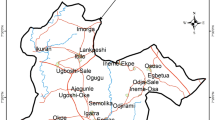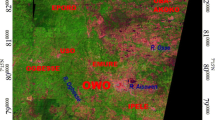Abstract
Groundwater being a valuable resource in today’s world needs proper evaluation and management for overall development within the region for its judicious use. The Baghmundi Block of Purulia district, West Bengal is within the hard rock terrain of Ayodhya hills and Matha Protected forest. The groundwater in this region is confined within the fracture zones and weathered residuum. Hydrogeomorphologically, the entire area is classified into following categories such as - i) Very shallow weathered pediment, ii) Moderately weathered pediment, iii) Valley fills, iv) Erosional gullies, v) Lateritic Upland and vi) Accumulation gullies.
The hydrogeomorphic map of the area prepared by Department of Science and Technology, Govt. of West Bengal has been digitized for the present study. The lineament map has been prepared from the satellite imagery. The lineament map has also been digitized for the present study. From this the lineament density contour map has been prepared. An integrated remote sensing and Geographic Information System (GIS) based methodology has been used for the delineating Groundwater potential zones in the study area. Here the Geomorphology and Lineament density maps are overlaid following the Weighted Index Overlay Method, which delineates groundwater potential zones.
Similar content being viewed by others
References
Chakraborty, P. (1996). Report of the Integrated Mission for Sustainable Development, Baghmundi Block, Purulia district, West Bengal. State Remote Sensing Centre, West Bengal.
Chatterjee, R.S. and Bhattacharya, A.K. (1995). Delineation of the drainage pattern of a coal basin related inference using satellite remote sensing techniques.Asia Pacific Remote Sensing J.,1: 107- 114.
Choudhury, P.R. (1999). Integrated remote sensing and GIS techniques for groundwater studies in part of Betwa basin. Ph.D. Thesis (unpublished). Department of Earth Sciences, University of Roorkee.
Drury, S.A. (1990). Image Interpretation in Geology. 2nd edn., Chapman & Hall, London, 281 p.
Gupta, R.P. (1991). Remote Sensing Geology. Springer- verlag, Germany, 356p.
Horton, R.E. (1945). Erosional development of streams and their drainage basins: Hydrophysical approach to quantitative morphology.Geol. Soc. Am. Bull.,56: 275–370.
Kumar, Ashok and Srivastava, S.K. (1991). Geomorphological unit, their geohydrological characteristics and vertical electrical sounding response near Munger, Bihar.J. Indian Soc. Remote Sensing,19(4): 205–215.
Lillesand, T.M. (1989).Remote Sensing and Image interpretation, John Wiley and sons, U.S.A., 721p.
Niyogi, D. (1987). Stepped erosion surfaces of Chhotanagpur Plateau Fringe.Indian Jour. Earth Sciences,14(3&4): 261–271.
Ravindra, K.V. (1997). Drainage morphometry analysis and its correlation with geology, geomorphology and ground water prospects in Zuvari basin, South Goa, using remote sensing and GIS,Proc. Nal Sym-remote sensing for natural resource with special emphasis on water management, held at Pune during Dec. 4–6, 1996, pp.270–296.
Saraf, A.K. and Chowdhury, P.R. (1998). Integrated remote sensing and GIS for groundwater exploration and identification of artificial recharge sites.International J. of Remote Sensing,19(10): 1825–1841.
Sharma, D. and Jugran, D.K. (1992). Hydromorphological studies around Pinjaur-Kala Amb area, Ambala district (Haryana), and Sirmour district (Himachal Pradesh).J. Indian Soc. Remote Sensing,29(4): 281- 286.
Srinivasan, P. (1988). Use of remote sensing techniques for detailed hydrogeological investigations in parts of Narmadasagar Command Area, MP.Photonirvachak, J. of the Indian Society of Remote Sensing,16(1): 55–62.
Subba Rao, N., Chakradhar, G.K.J. and Srinivas, V. (2001). Identification of groundwater potential zones using remote sensing techniques in and around Guntur town, Andhra Pradesh, India.J. Indian Soc. Remote Sensing,29(1&2): 69–78.
Tiwari, A. and Rai, B. (1996). Hydrogeological mapping for ground water prospecting using Landsat-MSS images-A case study of part of Dhanbad District, Bihar.J. Indian Soc. Remote Sensing,24(4): 281–286.
Author information
Authors and Affiliations
Corresponding author
About this article
Cite this article
Nag, S.K. Application of lineament density and hydrogeomorphology to delineate groundwater potential zones of Baghmundi block in Purulia District, West Bengal. J Indian Soc Remote Sens 33, 521–529 (2005). https://doi.org/10.1007/BF02990737
Received:
Revised:
Issue Date:
DOI: https://doi.org/10.1007/BF02990737




